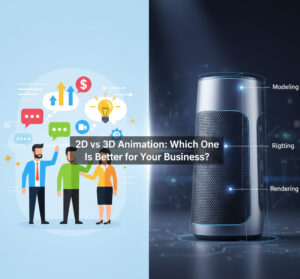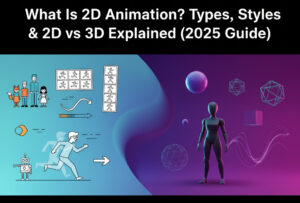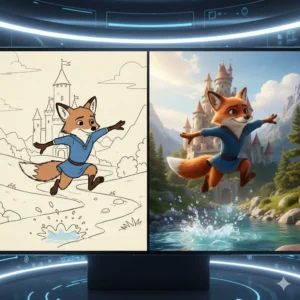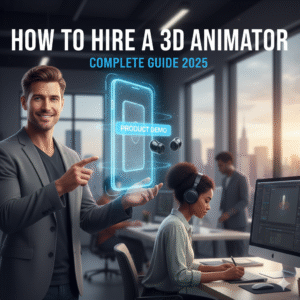If you’ve ever watched a Saturday morning cartoon, scrolled through animated social media ads, or enjoyed an explainer video online, you’ve already interacted with 2D animation one of the most popular and versatile animation techniques in the world. But what is 2D animation, how does it work, and why is it still so relevant in 2025, despite the boom of 3D animation?
In this beginner-friendly guide, we’ll break everything down in simple, conversational language without skipping the technical details that matter. By the end, you’ll understand the types of 2D animation, the most popular 2D animation styles, how it compares to 3D, and whether it’s easy to learn. We’ll also explore real-world applications, professional services, and examples so you know exactly when and how 2D animation is used.
Let’s dive in.
1. What Is 2D Animation? (Simple Definition for Beginners)
2D animation is the process of creating movement in a two-dimensional space, meaning the characters, backgrounds, and objects have height and width but not depth. Every action, expression, and transition happens on a flat plane, similar to how images appear on a piece of paper.
In simple terms:
2D animation is like drawing pictures and making them move through a sequence of frames.
Classic cartoons like Tom & Jerry, modern YouTube animations, and app interface animations all rely on 2D techniques.
What makes 2D animation unique?
- It focuses on flat drawings rather than 3D models.
- Movements are created frame by frame or with digital rigging.
- It offers high artistic freedom, stylized visuals, and expressive storytelling.
- It’s widely used for marketing, gaming, education, entertainment, and UI animation.
Whether you’re a beginner or a business exploring custom 2D animated videos, understanding this foundation is essential.
2. How Does 2D Animation Work? (Step-by-Step Breakdown)
Modern 2D animation uses powerful software rather than pen-and-paper techniques (though traditional methods still exist). Here’s a simple breakdown of how 2D animation works:
Step 1: Concept Development
Every animation starts with a story idea, script, or message. This step defines:
- Main characters
- Target audience
- Purpose (e.g., animated explainer videos, product demos, marketing ads)
Step 2: Storyboarding
A storyboard maps out scenes shot by shot. Think of it as a visual blueprint that helps animators and designers plan the flow of the animation.
Step 3: Character & Background Design
Artists create:
- Character models
- Background environments
- Props & assets
These designs define the animation art style, whether cartoony, minimalistic, anime-inspired, or hyper-stylized.
Step 4: Animating the Movement
This is where the magic happens. There are two main methods:
- Frame-by-frame animation
- Rigged (cut-out) animation
More on these in the types section below.
Step 5: Adding Sound
Animators sync voiceovers, sound effects, and music to enhance the storytelling.
Step 6: Final Rendering & Editing
The finished animation is exported and refined for platforms like YouTube, social media, websites, or apps.
Even though the tools are more advanced, the core principle remains the same: creating the illusion of movement with sequential images.
3. Is Making 2D Animation Easy? (Honest Answer)
The big question beginners ask is, is making 2D animation easy?
Here’s the truth:
Easy to Start
2D animation is considered more beginner-friendly than 3D because:
- You don’t need advanced modeling or rendering skills.
- Many tools are intuitive (e.g., Toon Boom, Adobe Animate, and Procreate).
- Simple animations can be created even with basic drawing abilities.
Hard to Master
Professional 2D animation requires:
- Strong drawing skills
- Understanding motion, timing, and anatomy
- Storytelling and pacing
- Mastery of animation techniques
So while creating simple animations is easy, producing studio-quality content takes time, practice, and creativity.
4. Types of 2D Animation (With Examples)
There are several types of 2D animation, each used for different purposes.
1. Traditional (Hand-Drawn) Animation
Every frame is drawn by hand. It’s the most time-consuming but also the most expressive.
Examples:
- Early Disney films
- Anime hand-drawn scenes
2. Digital Frame-by-Frame Animation
Same as traditional animation, but done digitally using software.
Perfect for:
- YouTube animations
- Creative storytelling
- Short films
3. Cut-Out Animation (Rig-Based)
Characters are built like digital puppets with movable parts connected by “bones.”
Used for:
- Explainer videos
- Educational animations
- Corporate videos
- TV shows (South Park, simplified rig style)
4. Vector-Based Animation
Uses mathematical curves instead of pixel art, allowing endless scaling without losing quality.
Ideal for:
- Apps and websites
- Motion graphics
- Explainer videos
5. Stop Motion 2D Animation
Uses flat paper cutouts or digital layers moved manually.
Example:
- Monty Python cut-out sketches
These different types of 2D animation give creators flexibility to choose based on time, budget, and artistic goals.
5. Popular 2D Animation Styles (2025 Guide)
Animation styles define the visual look of a project. Here are the trendiest 2D animation styles in 2025:
1. Cartoon Style
Classic, fun, expressive. Big eyes, exaggerated motions.
2. Flat Design
Simple shapes, minimal shading. Modern and clean great for business videos.
3. Anime Style
Japanese-inspired, emotional, and detailed.
4. Motion Graphics
Perfect for marketing, product demos, and presentations.
5. Minimalist Line Art
Elegant, thin lines, often monochrome.
6. Retro Pixel Art
Nostalgic and ideal for video games or indie projects.
7. Hand-Drawn Brush Style
Artistic, textured, organic.
Choosing the right style helps communicate brand identity and storytelling effectively.
6. 2D Animation Examples (Real-World Uses)
2D animation appears everywhere even in places most people don’t notice. Here are some common 2D animation examples:
- YouTube animated stories
- TV cartoons
- Educational videos for kids
- Mobile game characters
- Animated infographics
- Ads on Instagram, TikTok, and YouTube
- UI animations in apps
- Animated logos
- Interactive learning apps
Whether you’re creating fun content or teaching complex concepts, visual storytelling through 2D animation is incredibly powerful.
7. What Is the Difference Between 2D and 3D Animation?
If you’re comparing animation methods, you’ve likely wondered, what is the difference between 2D and 3D animation?
Here’s a simple breakdown:
2D Animation
- Flat drawings
- Height + width
- Artistic and stylized
- Faster and cheaper
- Great for explainer videos, ads, and cartoons
3D Animation
- Uses digital models
- Height + width + depth
- Realistic movements
- More expensive and complex
- Common in movies, games, and immersive content
Key Differences
| Feature | 2D Animation | 3D Animation |
|---|---|---|
| Dimensionality | 2D plane | Three-dimensional models |
| Cost | Lower | Higher |
| Learning Curve | Easier | Steeper |
| Style | Artistic, stylized | Realistic or stylized |
| Production Speed | Faster | Slower |
| Best For | Marketing, education, apps | Films, AAA games |
Both are powerful, but each serves different creative goals.
8. Animation Techniques Behind 2D Animation
To understand 2D animation at a deeper level, here are the core animation techniques professionals use:
- Squash and stretch
- Anticipation
- Staging
- Timing and spacing
- Arcs of movement
- Follow-through & overlapping action
- Ease in & ease out
- Secondary action
These principles bring characters to life and make animations feel natural, fluid, and expressive.
9. Professional 2D Animation Services You Can Use (2025)
Businesses love 2D animation because it’s affordable, fast, and versatile. Common professional 2D animation services include:
- Custom 2D animated videos
- Animated product demos
- Explainer videos
- Brand storytelling videos
- Educational animation content
- Social media animations
- UI/UX interactive animation
- Marketing ads and promos
If you’re a company looking to elevate visuals, hiring professional animators can dramatically improve engagement.
10. How to Hire 2D Animators or a Studio
If you’re ready to create your project, you can either hire freelancers or partner with a studio.
Freelancers
Ideal for:
- Small projects
- Quick social media clips
- Limited budgets
Studios
Look for the best 2D animation studio in the USA or global options if you need:
- Large-scale productions
- Complex animations
- Scriptwriting + voiceover + full production
When choosing, check:
- Portfolio
- Animation styles
- Pricing
- Reviews
- Turnaround time
Search terms like “hire 2D animators” or “2D animation for product demos” to explore options.
11. Where 2D Animation Shines in 2025 (Latest Trends)
Thanks to digital tools and AI-assisted workflows, 2D animation continues to evolve. Key trends include:
- Interactive animation for apps and websites
- Hyper-stylized marketing videos
- 2D animation in indie game development
- Educational micro-learning animation
- Personalized animated ads
- Social media storytelling
Even with 3D and VR growing, 2D animation remains irreplaceable for fast, artistic, and accessible content creation.
Conclusion
2D animation remains one of the most powerful creative mediums in the digital world. Now that you know what 2D animation is, how it works, and how it compares to 3D, you can confidently choose the right style and technique for your project. Whether you’re exploring this field as a beginner or planning to use it for business, the possibilities are endless.
From marketing videos to educational content, from product demos to entertainment 2D animation continues to thrive because it’s expressive, cost-effective, and limitless in creativity.
No matter your goals, understanding these fundamentals opens the door to endless visual storytelling opportunities.
FAQs
1. What is 2D animation in simple terms?
2D animation is the process of creating movement in a two-dimensional space using flat characters and backgrounds. It’s widely used in cartoons, explainer videos, ads, and digital storytelling.
2. How does 2D animation work?
2D animation works by drawing or rigging characters and making them move frame by frame. Modern software allows animators to design, animate, and render scenes digitally.
3. What are the main types of 2D animation?
The main types include traditional hand-drawn animation, digital frame-by-frame animation, cut-out animation, vector animation, and stop-motion 2D.
4. What is the difference between 2D and 3D animation?
2D animation uses flat drawings with height and width, while 3D animation uses models with depth. 2D is best for stylized stories and explainer videos, whereas 3D is ideal for realistic films and games.
5. Is making 2D animation easy for beginners?
Yes, beginners can start easily because many tools are user-friendly. However, mastering professional 2D animation requires practice, creativity, and strong visual storytelling skills.
6. What are the most popular 2D animation styles?
Popular styles include cartoon style, anime, flat motion graphics, minimalist line art, retro pixel art, and hand-drawn brush styles.
7. Where is 2D animation used today?
2D animation is used in marketing videos, TV shows, product demos, educational animations, social media ads, UI animations, and interactive content.
8. Why do businesses use 2D animation?
Because it’s affordable, fast to produce, and visually engaging perfect for boosting conversions, explaining products, and improving brand storytelling.
9. Can I hire professional 2D animators for custom videos?
Yes, you can hire freelance animators or partner with a top 2D animation studio to create explainer videos, product demos, social media animations, and more.
10. What software is best for beginners learning 2D animation?
Beginner-friendly options include Adobe Animate, Toon Boom Harmony, Procreate, Krita, and OpenToonz.






